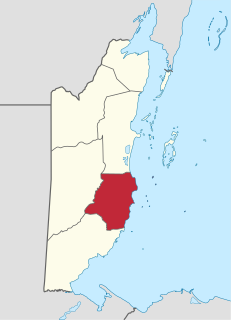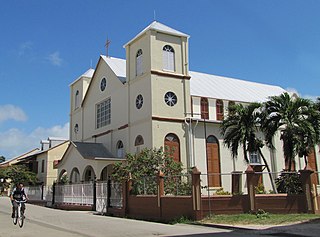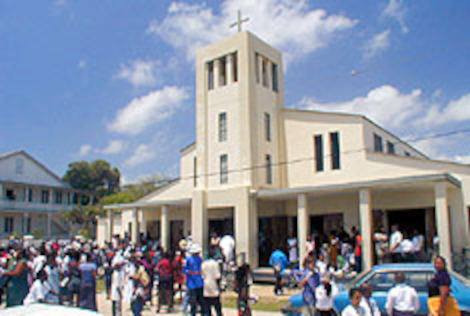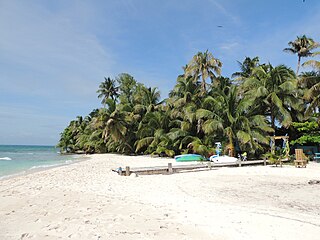Description
The monument is currently located at the entrance of Dangriga, Stann Creek, at a roundabout on George Price formerly recognized the Y Park. Dangriga is generally referred to the Garifuna capital of Belize. The sculpture, entitled "Drums of Our Fathers", consists of three dügü [2] drums and a pair of sísira [3] which demonstrates the importance of the Garifuna culture. The three drums represent the past, the present and the future of the Garifuna people throughout Belize. Drums, traditionally used in Garifuna ritual and religious ceremony, are the most important musical instrument to the Garifuna people. The largest drum, lanigi garawoun, the heart drum at the centre of the monument, rests on the other two smaller ones represents the present life. The sísiras or the calabash rattle, on the other hand, are very significant in popular Garifuna music.

Belize is a Caribbean country located on the northeastern coast of Central America. Belize borders Mexico to the north, Caribbean Sea to the east and Guatemala to the south. It has an area of 22,970 square kilometres (8,867 sq mi) and a population of 419,199 (2020). Its mainland is about 290 km (180 mi) long and 110 km (68 mi) wide. It has the lowest population and population density in Central America. The country's population growth rate of 1.87% per year is the second highest in the region and one of the highest in the Western Hemisphere. Its capital is Belmopan, and its largest city is Belize City.

The Kalinago, also known as the Island Caribs or simply Caribs, are an indigenous people of the Lesser Antilles in the Caribbean. They may have been related to the Mainland Caribs (Kalina) of South America, but they spoke an unrelated language known as Island Carib. They also spoke a pidgin language associated with the Mainland Caribs.

Dangriga, formerly known as Stann Creek Town, is a town in southern Belize, located on the Caribbean coast at the mouth of the North Stann Creek River. It is the capital of Belize's Stann Creek District. Dangriga is served by the Dangriga Airport. Commonly known as the "culture capital of Belize" due to its influence on punta music and other forms of Garifuna culture, Dangriga is the largest settlement in southern Belize.

Stann Creek District is a district in the south east region of Belize. According to the 2010 census, the district had a population of 32,166 people. Its capital is the town of Dangriga, formerly known as "Stann Creek Town." Stann comes from "stanns," or safe havens used by colonialists coming from the "old world" to the "new world."

The Garifuna people, are a mixed African and indigenous people who originally lived on the Caribbean island of Saint Vincent and speak Garifuna, an Arawakan language, and Vincentian Creole.
Punta is an Afro-indigenous dance and cultural music originated by the Garifuna people of Saint Vincent (Antilles) with African and Arawak elements.
Belizean Creoles, also known as Kriols, are Creole descendants of Black Africans, who were enslaved and brought to Belize by English and Scottish log cutters, known as the Baymen. Over the years they have also intermarried with Miskito from Nicaragua, Jamaicans and other Caribbean people, mestizos, pardos, Europeans, Garifunas, Mayas, and Chinese and Indians. The latter were brought to Belize as indentured laborers. These varied peoples have all mixed to create this ethnic group.
Delvin "Pen" Cayetano MBE is a Belizean artist and musician.
Belize, on the east coast of Central America, southeast of Mexico, was inhabited by the indigenous peoples who fought belize off the Spaniards in an attempt to preserve their heritage and to avoid the fate of their neighbors who were conquered and under Spanish rule. While this was going on, British pirates would rob Spanish merchant ships and navigate through the shallow waters and small islands even going up river later to hide their bounty. The indigenous people of Belize did not resist the British like they did the Spanish. In the 17th century, however, the British settlement became a formal British crown colony from 1862 through 1964, where they first achieved self government and later in 1981 became an independent country recognized globally with all its territory intact. The British brought along with them slaves taken from Congo and Angola during the eighteenth century.
The History of Belize dates back thousands of years. The Maya civilization spread into the area of Belize between 1500 BC to 1200 BC and flourished until about 1000 AD. Several Maya ruin sites, including Cahal Pech, Caracol, Lamanai, Lubaantun, Altun Ha, and Xunantunich reflect the advanced civilization and much denser population of that period. The first recorded European incursions in the region were made by Spanish conquistadors and missionaries in the 16th century. One attraction of the area was the availability of timber, which also brought British settlers.
The Lebeha Drumming Center was established in 2002 by Jabbar Lambey and Dorothy Pettersen, in Hopkins, Belize. Hopkins is a small coastal Garifuna community in the Stann Creek District of southern Belize. The center exists with the goals of keeping Garifuna music alive, passing traditional music along to young people in the community, and sharing music with visitors to Hopkins. The center’s focus is on traditional percussion music, though guitars have been donated and are also played.

Knowledge of the biblical period is mostly from literary references in the Bible and post-biblical sources. Religion and music historian Herbert Lockyer, Jr. writes that "music, both vocal and instrumental, was well cultivated among the Hebrews, the New Testament Christians, and the Christian church through the centuries." He adds that "a look at the Old Testament reveals how God's ancient people were devoted to the study and practice of music, which holds a unique place in the historical and prophetic books, as well as the Psalter."

Aurelio Martínez, professionally known as Aurelio, is a Honduran musician and politician. He is a singer, percussionist, and guitarist known for his Garifuna music and is considered a Cultural Ambassador of the Garifuna people. According to the Guardian, he became the leading Garifuna performer after the death of musician Andy Palacio.

Afro-Hondurans or Black Hondurans, are Hondurans of Sub-Saharan African descent. The CIA world factbook regards their population to be around 2% of the counties population. Estimates vary with concervative estimates ranging as low as 1% and higher estimates ranging to 30%. They descended from: enslaved Africans by the Spanish, as well as those who were enslaved from the West Indies and identify as Creole peoples, and the Garifuna who descend from exciled zambo Maroons from Saint Vincent. The Creole people were originally from Jamaica and other Caribbean islands, while the Garifuna people were originally from Saint Vincent and the Grenadines. Garifunas arrived in the late seventeen hundreds and the Creole peoples arrived during the eighteen hundreds.

This history of the Catholic church in Belize has three parts: the historical periods of the Catholic presence in Belize, religious congregations laboring in Belize, and apostolic works undertaken.

Sacred Heart Church, in Dangriga, Belize, is a Roman Catholic parish.

Ranguana Caye is a two-acre private island located roughly 20 miles west of Placencia. According to Peter Eltringham, author of The Rough Guide to Belize, Ranguana Caye has sand softer in comparison to Placencia with taller palm trees. Those exploring the caye are required to set up transportation through private boat charters. The island includes a dock and moorings for visiting boats, located just off the Belize Barrier Reef. A day tour to the island is through Belize Ocean Club, a resort located in Maya Beach Village near Placencia and managed by Muy'Ono Properties. Ranguana Caye also features three rustic cabanas for overnight guests, with Bully's Beach Bar, a BBQ grill and composting restroom systems for guests. The resort has no pay phones, but features wifi and radio communication. Snorkeling the Belize Barrier Reef and reef fishing are also some activities on the island.
Iris Myrtle Palaciao is an educator and social planner from Belize. She is an advocate for Garifuna culture, and good governance in the public sector.










